#xi'an city walls
Explore tagged Tumblr posts
Text
April 11-14, Xi'an, China:
Some pictures of the cultural landmarks of Xi'an and some miscellaneous pics to wrap up the posts about my Xi'an trip:
First is the Bell Tower/钟楼 and Drum Tower/鼓楼 of Xi'an. The Bell Tower and the Drum Tower of Xi'an were built in 1384 and 1380 respectively, during the reign of Emperor Taizu of Ming (personal name Zhu Yuanzhang, aka that one emperor who was a beggar). Both towers were rebuilt during Qing dynasty, then repaired extensively in the latter half of 20th century.
This square-ish tower is the Bell Tower:
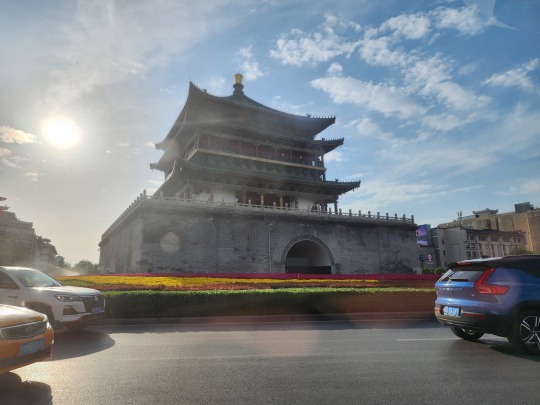
The hotel we stayed at was fairly close to the Bell Tower so I was able to get a couple more pictures of it, but we didn't go inside either towers though. I kind of regret that, but I regret not being able to go to the Shaanxi History Museum more.


Side note: the Tang-era Jingyun Bell/景云钟 used to be inside this tower (hence the name), where it would sound in the mornings to signal the beginning of the day. However, the Jingyun Bell was moved to Beilin Museum in 1953 for conservation purposes, which was also where I saw the real thing (see my earlier post about Beilin Museum), but a tour guide told me it would be moved again soon to another (indoor) museum, where it would stay for the foreseeable future. The bell that is inside the Bell Tower right now is a modern working replica of the Jingyun Bell.

And now the rectangular Drum Tower. The drums in the tower used to sound in the evenings, signaling the end of the day. This is summed up in the term 晨钟暮鼓, or "morning bell tolls and evening drum beats".

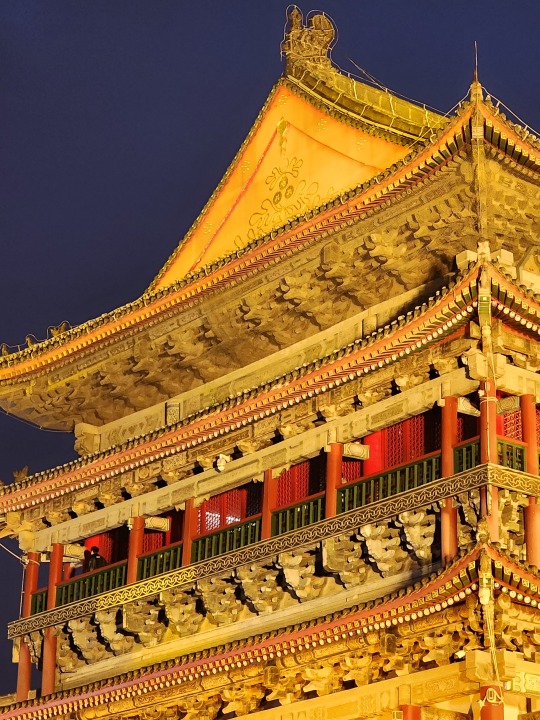
The bian'e/匾额 sign on the south side of the Drum Tower reads 文武盛地 (traditionally Chinese reads from right to left when written horizontally), which translates to "the place where literary and martial arts flourish". The bian'e itself is 8m (~26.2 ft) long and weighs 2-3 metric tons (about as heavy as a SUV). The bian'e on the north side of the Drum Tower reads 声闻于天, which translates to "a sound heard even in the heavens", referring to the sound of the drums. The phrase itself came from the poem "A Crane Cries" (鹤鸣; translation may vary depending on the translator) from the Classic of Poetry/《诗经》.

On to notable souvenirs from random shops:
Tang-era style Thicc Beefcake Horses 👌

Left: figurines of (mostly) Tang-era girls. Right: a type of candy from Sichuan called "dogshit candy"/狗屎糖 (yes that's really the name lol) made from soy beans, peanuts, and barley malt syrup (called maiyatang/麦芽糖). The smaller text on the bottom of the bag reads "eat dogshit candy and you will have dogshit luck", which actually means good luck btw, because the chances of stepping on dog doo-doo is actually kinda low if you think about it
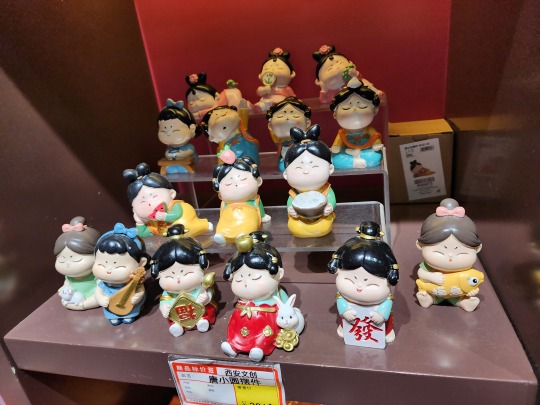

And last but not least, the ancient city walls of Xi'an. The city walls that we see here were built at the beginning of Ming dynasty (latter half of 14th century), but analysis of the cross section revealed that it also contained sections of the Tang-era (618 - 907), Song-era (960 - 1279), and Yuan-era (1206 - 1368) city walls within it in layers. These walls are 12m (39.4ft) tall and the top of the wall is 12-14m (39.4-46ft) wide, enough to pass multiple horse-drawn carts at once, which was important for the defense of the city. Below is the Anyuan Gate/安远门 (the north gate), and this used to be where the Tang-era Taiji Palace/太极宫 (not to be confused with Taiji Hall of the Forbidden City) wall connected with the Eastern Palace/东宫, where the crown prince resided:
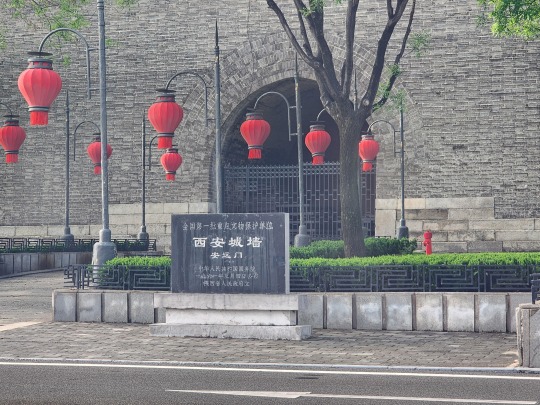
Coming around the side gate of Anyuan Gate. There's also a moat (护城河 in Chinese, lit. "protect city river"), but I didn't take pictures of it.

Outside the Shangwu Gate/尚武门. 尚武 roughly translates to "respect of the martial". There used to be draw bridges outside these gates as well, but for ease of modern transportation, most of them have been rebuilt as fixed bridges with roads on top for vehicles and pedestrians. The only draw bridge that has been rebuilt (that I know of) was the one outside the Yongning Gate/永宁门 aka the southern gate.

Leaving Xi'an city. These are the corner towers of the city wall:


Two cute sculptures inside the Xi'an Xianyang International Airport/西安咸阳国际机场, the left one represents Shaanxi's Qinqiang/秦腔 folk opera, and the right one is, of course, the famous terra cotta soldier:

Goodbye Xi'an! Hopefully I can come back in the future and go to Shaanxi History Museum..........

#2024 china#xi'an#china#bell tower#drum tower#xi'an city walls#chinese architecture#chinese history#chinese culture#architecture#history#culture
64 notes
·
View notes
Text
ABONNEMENT 12 MOIS IPTV
ABONNEMENT 12 MOIS IPTV
Inclus tous les bouquets et VOD
24h/7j Full Support
Installation IPTV Maroc Gratuite
Mise a jours playlist IPTV
4K/FHD/HD/SD Qualité
Stable & Rapide
click now

#zip code quezon city#zamboanga city#zip city#zahia city center#zillow kansas city#zillow salt lake city#zayed sports city#zinque century city#zona rosa kansas city#zanzibar city#york city fc#ybor city#yuba city#yarra city council#yauatcha city#yunobo of goron city#yazoo city#ybor city shooting#york city walls#you belong to the city#xtreme city#xhale city#xochimilco mexico city#xtreme city movie#xxi senayan city#xi'an city#xxi gandaria city#xxi kuningan city#xaven ft celeb city#xenia city
0 notes
Text
[23/11/23] #BaiYu - BE PRESENT 专注在当下 | Translated Interview with SoFigaro Magazine
The following thread is a full translation of the 2023 November issue of SoFigaro. (First posted to Twitter here.)

Bai Yu is fond of taking photos of things that grow upwards.
During his photoshoot breaks, he would snap some photos of trees standing tall and swaying gently in the autumn wind, and some reeds in the distance.
The top of the pine trees in the cold November rain, the city walls that extend upwards, and the ancient corner towers that pierce into the sky…
These are things he likes to take photos of.
Perhaps all these have one thing in common.
Over time, they may seem to be standing tall and still, but in reality, they have been quietly absorbing and silently expressing themselves.
Parallel World
Following the conclusion of the Parallel World episodes, Bai Yu bid Chang Dong goodbye with a group of photos.
During the interview, he explained, "These are the yardangs we encountered along the way. This is an abandoned village, and this is where Chang Dong encountered an incident…" Although filming is complete, precious memories of this story are all carved into Bai Yu's mind.
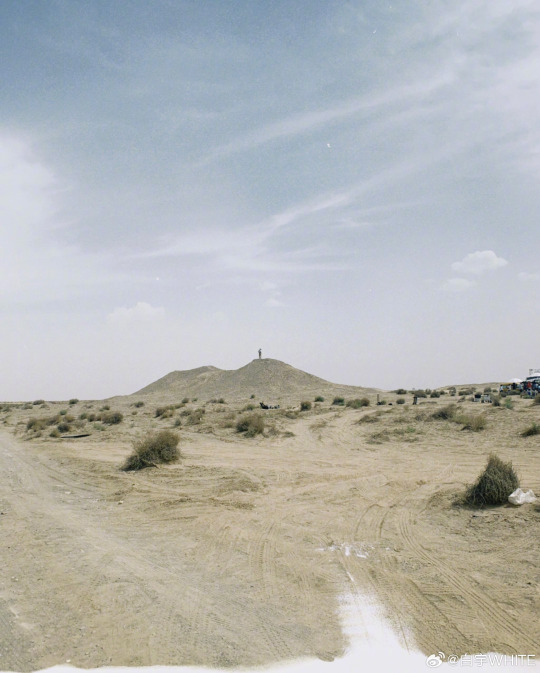
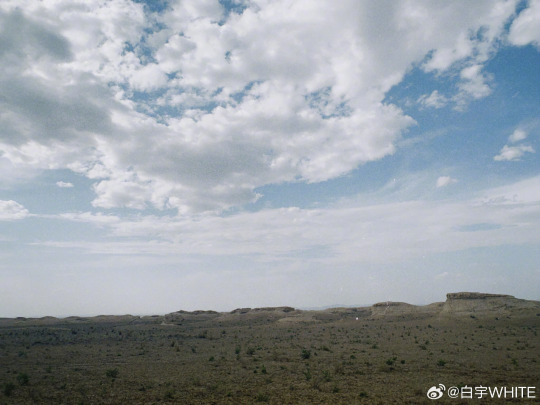


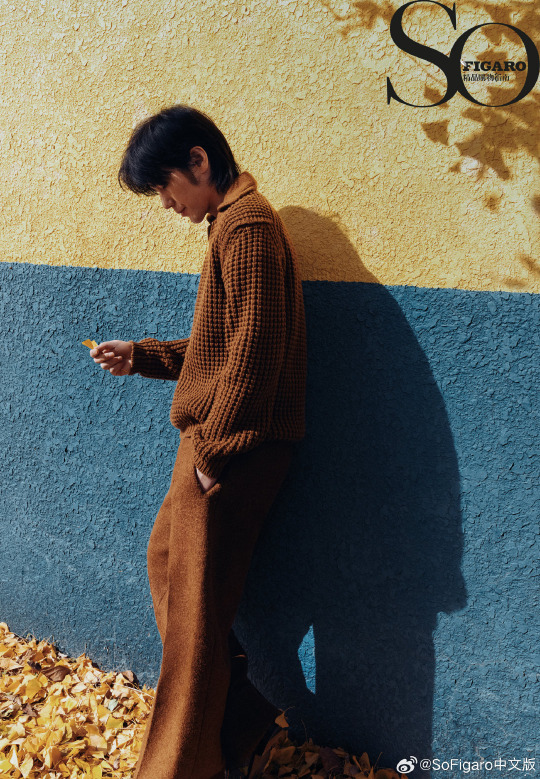
Since ancient times, the Yumen Pass has always been an important landmark to the poets. It is an important frontier pass established along the Hexi Corridor during the Han dynasty. And today, it has become a heritage site.
To protect the area, most of the filming took place in the vast and endless Dunhuang desert. 'In boundless desert lonely smokes rise straight; over endless river the sun sinks round' (1)… The scenery described in the poem was right before his eyes. It was gorgeous, but they also had to tackle challenges brought on by the harsh environment.
Bai Yu recalled...
"We shot during June, so the winds were strong and it was the sunniest period. It was hard to illuminate the area at night in the desert, so a lot of scenes were shot day for night. Shooting under the scorching sun and in fierce winds did have some impact on performance."
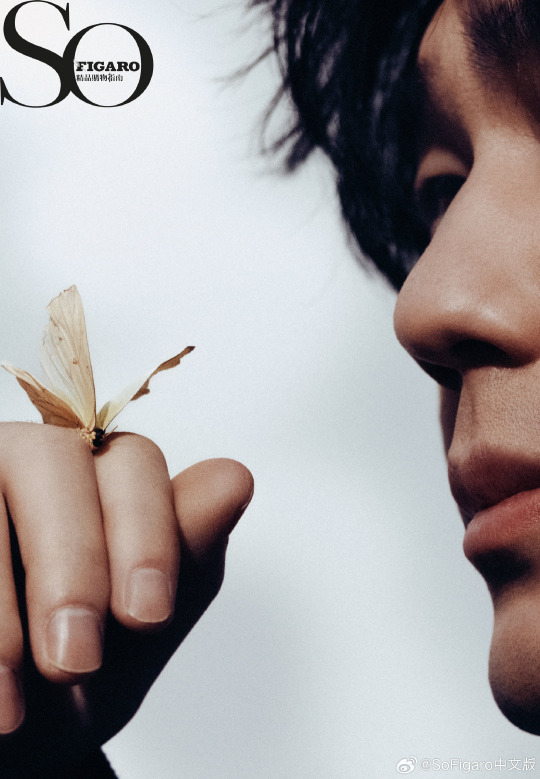
One night, the giant tent the staff had set up securely was blown away by the wind. "The tent was huge, with really thick poles and sturdy ropes holding it down. Who knew that the next day it'd be missing, completely blown away by the wind!"
When time allowed, Bai Yu would drive his car to and from work, driving back to where he'd rest after the crew wrapped filming. "Nobody was around where we filmed, so knocking off and driving a jeep in this vast land felt great."


Whenever Bai Yu wraps up filming for a drama, he gives himself an extended break. Recently, he returned home to Xi'an and recharged with a bowl of hot oil noodles (2). Going back home is something Bai Yu often looks forward to the most after completing a project. After all, fully immersing oneself in a role is a significant test on an actor's physical and mental well-being. "Only when I'm back home can I unload and relax."
This year, Bai Yu also visited Wubu County, where he was born.
"I was born in a yaodong (3) that my parents built themselves, and it still stands today." Beside their yaodong are aging neighbors who could still recognize Bai Yu as that mischievous boy in their memories.

Some feel that the characters that Bai Yu has portrayed in the recent years carry this underlying theme of 'endurance.' We wondered if he felt 'bottled up' portraying such characters for some time.
Smiling, he replied, "A little, but you have to do something about it. So you need to rest properly to adjust." But every time he comes across a good script, he'd still be moved by the very authentic and rich characters.
.
.
.
After all, life isn't a feel-good drama. Struggles and compromises with things that turn out contrary to our wants are part and parcel of life.
Bai Yu had this to say…
"I used to be captivated by exciting stories, but now it's more the details that draw me in. These details should be used to portray a character instead of their embellished aspects. It's these details that let me get deeper into the character."


To Bai Yu now, there are no differences between 'important' and 'regular' scenes. People may enjoy discussing an actor's skill and portrayal of intense emotions in an important scene, but Bai Yu feels that shouldn't be all that makes a character.
"There are too many details happening all the time. It's like when I filmed 'The Long Night'; Jiang Yang is a character defined by many details."

The Long Night
Without a doubt, bringing up Bai Yu makes people immediately recall 'The Long Night.' Hearing this, he only laughed and said, "Then I have to reflect on myself. I don't have another work that makes people think of me this way. I have to keep working hard."
A lot of people say this is the work that successfully transformed him. To this, he responded, "These labels are given by others. I was never concerned with 'transformation' since that's what others define you. At the end of the day, it's about the performance and character, about what I like and what I feel fits me."
Before our interview, we came across something Bai Yu once said. He said that Jiang Yang was the first character that he just wanted to portray no matter what. Often, he would reflect on Jiang Yang afterward, and still felt dazed. It wasn't until the day 'The Long Night' premiered, a rainy day where he walked for a long time, that the weight in his mind finally lifted.
In a flash, the year is ending. We asked Bai Yu how he would sum this year up. He thought for a little while and said, "Never thought about it. I used to think time passes really quickly, so I took a long break this year. When I did, I thought time passed really slowly."
For a period of time, his tight schedule made him stop in his tracks to take the time to rest. To many actors, resting could mean missing opportunities.
"Of course, you could miss out on a good opportunity, a good script. But you need to first understand yourself. Can you do a good job if what you truly need is a good rest? If you encounter a good script that captivates you, that's great. But can you mentally tackle the task? Life is about making choices and sacrifices."
As the saying goes, one must take a step back in order to leap better. To Bai Yu, he has never stopped in his path as an actor, but only rested to make sure he has the energy to meet his next challenge.
Occasionally, the passing of time brings about certain thoughts. "A few days ago, I told my dad that I feel like I'm almost forty. He almost burst out laughing, saying, 'You're just in your early thirties!'" Bai Yu expressed that he felt this way because there are many things he still wants to do. Time has its own rhythm, whether fast or slow, but it shouldn't be a worry.
Summing things up, he said, "You set your rhythm. Don't be too bothered about how fast or slow time is going, just stay focused on the present. Live honestly and respect your own thoughts, no matter what it is you want to do. Just go ahead and pursue it!"
/END
TL notes: (1) From Wang Wei's "On Mission to the Frontier" (王维 《使至塞上》) (2) Hot oil noodles = you po mian (3) Yaodong = earth shelter
Mag link here Mag in text format here compiled by Sweetheart_白宇甜心
BUY THE MAG HERE (can be accessed via PC)! If you need help with purchase, let me know and I'll try to help.
#白宇#bai yu#bai yu for sofigaro#bai yu in this mag just looked cozy#and honestly he's right about needing to take time for yourself#you can only give your best if you're mentally prepared
43 notes
·
View notes
Text
A frozen fortress in one night?
Recently, there has been a huge amount of discussion about a particular frozen wall during the Battle of Tong Pass (Tongguan) on the Chinese internet, mainly due to the reconstruction attempt in this video (in Chinese). The video attracted a lot of attention as it was made by a game company to promote their 3k theme game, and because they chose to focus on such seemingly unimportant and negligible detail.
The explicit mention of a 'frozen wall' can be found in Chapter 59 of the Romance, but unlike many other wild ideas, this detail was in an annotation to the Records of the Three Kingdoms as well.
曹瞞傳曰:時公軍每渡渭,輒為超騎所衝突,營不得立,地又多沙,不可築壘。婁子伯說公曰:「今天寒,可起沙為城,以水灌之,可一夜而成。」公從之……比明,城立,由是公軍盡得渡渭。
The Caomanzhuan states: when Duke Cao's army crossed the Wei River, they were always struck by Ma Chao's cavalry and unable to land safely for camp establishment, and because the ground was sandy, no fortifications could be built. Lou Zibo [Lou Gui] suggested to the Duke, "Today the weather is cold, we can build walls with sand and fill them with water, and they will be built overnight [due to freezing]." Cao Cao accepted his suggestion.....by dawn, the walls were erected, and the Duke's army successfully crossed the Wei River.
This detail was of course not without controversy. Pei Songzhi in his annotations noted that some questioned the feasibility of water freezing when it was only the 9th month at that point. Indeed, when checking Tongguan County and Xi'an City climate data records today, their mean daily temperatures in October/November (roughly corresponding to the 9th month) sit well above the freezing point at about 6-15 degrees. Additionally, the Caomanzhuan is known for incorporating exaggerated tales and the ice wall's absence in Chen Shou's main text seems to imply that Chen Shou didn't deem this detail worthy or credible.
Some think otherwise. Pei Songzhi himself commented that at that point the temperatures may be cold enough for freezing, against the backdrop of a mini-cooling period during Chinese history. Caomanzhuan is also known as a piece that frequently paints Cao Cao in a bad light, so such a positive spin on Cao Cao and his advances seemed unlikely to be made up.
Regardless of what one thinks of the validity of this tiny detail, the video creators, with their interpretation of events, attempted and successfully recreated a frozen wall. Undeniably, this is at least partly a marketing gimmick, and a successful one given the responses. But it certainly is still very interesting to see an effort to explore the true history behind famous tales and legends, especially as a mere game studio.
7 notes
·
View notes
Text
Back from China
Now that I'm back in Canada after 26 days in China, here's a link to some of my photos (warning: there are over 500).
I usually travel on my own, and I was with my brother and dad this time, which was fun. I acted as their translator and tour guide (since to get anywhere you have to use Baidu, which is only in Chinese). It was interesting seeing China through their eyes, and we got to do things I wouldn't normally do on my own. We also didn't drive each other crazy - there were no fights, just some stressful moments (which happen when I'm alone too - just part of travel).
We were in Beijing, Wutai Shan, and Xi'an.
Wutai was very interesting - we were the only foreigners I saw for the entire 5 days. The weather was kinda treacherous, which I understand is pretty normal for Wutai. It was very beautiful, though. And we got our fill of temples - there are over 200 there. One of the more "off the beaten path" places I've gone to.
Xi'an is lovely. It's "only" 10 million people, and I'm discovering I quite like Chinese cities of this size. Still bustling and highly developed, but not overwhelming. Suzhou and Hangzhou are a similar size, and I also really love those cities. Xi'an has excellent local food - spicy and extremely garlicky. And of course wonderful historical sites. The terra cotta warriors are really amazing, and we timed our visit well because it wasn't super crowded when we went to see them.
Beijing is the 3rd "megacity" I've visited now, the other 2 being Tokyo and Shanghai. The advantage to cities like this is the endless variety of things you can see and do. You can never really see all of it. I intentionally spent longer there on this trip - 15 days in total - for this reason. We saw (this list is non-exhaustive): the Great Wall, the Forbidden City, the Temple of Heaven, Tiananmen Square, the Bell and Drum Towers, the hutongs (old traditional alley residences), Fragrant Hill, the National Centre for the Performing Arts, the Bird's Nest stadium, the Summer Palace, the National Botanical Garden, Ritan Park, and Black Bamboo Park. We also ate an incredible variety of Chinese food - Liu Yuning is right that you can find like every region's food there.
The drawback to megacities, in my mind, is that there are just way too many people for me! It's okay on weekdays, but on weekends and holidays (we were there for the mid-autumn festival long weekend) it's way too crowded no matter where you go. I love a bustling and lively city, but at that scale, it's too much for me.
The drawbacks to Beijing in particular, in my mind, are:
the security is way over the top - even more than any other place in China I've visited. Particularly within a certain radius of Tiananmen, where you get stopped for an ID check literally every block and you have to tell them where you're going. There are also a ton of places you're just not allowed to go that seem stupid to me, like their national sports stadium (near the Bird's Nest in their 2008 Olympic Park), Beijing University, and Tsinghua University (those are by appointment only and the appointments were fully booked even a week in advance).
the air pollution isn't as bad as I saw on TV during the 2008 Olympics, but it's still really bad a lot of the time (the air quality index was often around 150-170).
it's way too spread out. There aren't a lot of skyscrapers compared to Tokyo and Shanghai. It has the largest subway system in the world, but the subway stops are very far apart, so you end up walking a TON to get anywhere. Most people ride bikeshare bikes from the subway station, but we couldn't get the apps working for my brother and dad, despite trying multiple different bikeshare apps - it's a big hurdle for foreigners. If you use Didi (their version of Uber) or take the bus, the traffic is often really really slow.
So, although Beijing has a ton to see, I'm not in a rush to visit it again unless I'm going to meet up with a friend there or as a landing point to visit somewhere else.
As usual, I also did a ton of shopping when I was there, and brought back an extra suitcase (which I also bought) full of stuff with me. I also did some online shopping when I was there. Taobao wouldn't work for me because Alipay wouldn't accept foreign credit cards on it (although you can use Alipay for a ton of other stuff there, including the subway, and I used it quite a bit), so I used Jingdong. It's dangerously convenient! I discovered that Taobao does work in Canada, though, with your Canadian credit card. This could end up being a bad habit!
Haha, I was only gonna write a short post but I got carried away. I need to get ready for work. More perhaps later. Let me know if there's anything in particular you would like to hear about.
5 notes
·
View notes
Text
From the Great Wall to the Bund: Top Destinations in China

China's history is a tapestry of rich, diverse, and complex events that have shaped not only the country itself but also the world. With a recorded history spanning over 3,000 years, China is one of the world's oldest civilizations. The early Chinese civilization emerged in the Yellow River Valley, known as the cradle of Chinese civilization.
The Xia Dynasty (c. 2070-1600 BCE) is often considered the first Chinese dynasty, though its existence is sometimes debated due to the lack of written records. The Shang Dynasty (c. 1600-1046 BCE) followed, leaving behind the earliest known Chinese writing system and significant advancements in bronze work. The Zhou Dynasty (1046-256 BCE) introduced the concept of the Mandate of Heaven, which justified the rule of the emperor as divinely sanctioned.
China's imperial history is marked by the rise and fall of dynasties. The Qin Dynasty (221-206 BCE) unified China for the first time under Emperor Qin Shi Huang, who also began the construction of the Great Wall. The Han Dynasty (206 BCE-220 CE) saw the expansion of the Silk Road and significant cultural and technological advancements. Subsequent dynasties, such as the Tang (618-907) and Song (960-1279), were periods of cultural flourishing and economic prosperity.
The Yuan Dynasty (1271-1368), established by the Mongol leader Kublai Khan, marked a period of foreign rule. The Ming Dynasty (1368-1644) restored Han Chinese rule and is famous for its naval expeditions and the construction of the Forbidden City in Beijing. The Qing Dynasty (1644-1912), established by the Manchus, was the last imperial dynasty of China.
The 20th century brought dramatic changes with the fall of the Qing Dynasty, the establishment of the Republic of China in 1912, and the subsequent Chinese Civil War. The People's Republic of China was founded in 1949 under the leadership of the Communist Party, with Mao Zedong as its first leader. Since then, China has undergone rapid economic development and transformation, emerging as a major global power.
Places to Explore
The Great Wall of China: One of the most iconic landmarks in the world, the Great Wall of China stretches over 13,000 miles across northern China. Originally built to protect against invasions, the Wall is a testament to China's engineering prowess and historical determination. Popular sections to visit include Badaling, Mutianyu, and Jinshanling.

The Forbidden City: Located in the heart of Beijing, the Forbidden City served as the imperial palace for 24 emperors during the Ming and Qing dynasties. This sprawling complex of palaces, halls, and gardens is a UNESCO World Heritage Site and offers a glimpse into the opulent lives of China's emperors.

Terracotta Army: Discovered in 1974 near Xi'an, the Terracotta Army is a collection of thousands of life-sized clay soldiers buried with China's first emperor, Qin Shi Huang. Each figure is unique, and the site is considered one of the greatest archaeological finds of the 20th century.
Zhangjiajie National Forest Park: Famed for its towering sandstone pillars, Zhangjiajie National Forest Park in Hunan Province inspired the floating mountains in the movie "Avatar." The park offers breathtaking landscapes, glass-bottomed bridges, and the world's longest and highest glass bridge.

Li River and Yangshuo: The Li River in Guangxi Province is renowned for its picturesque karst landscape. A cruise down the river from Guilin to Yangshuo offers stunning views of limestone peaks, bamboo groves, and traditional fishing villages. Yangshuo, with its laid-back atmosphere and outdoor activities, is a popular destination for travelers.
The Bund in Shanghai: Shanghai's Bund is a waterfront promenade along the Huangpu River, offering a striking contrast between the colonial-era buildings and the futuristic skyline of Pudong across the river. The Bund is a symbol of Shanghai's historical and modern transformation.
Potala Palace: Perched atop Marpo Ri hill in Lhasa, Tibet, the Potala Palace is a stunning example of Tibetan architecture and a spiritual center for Tibetan Buddhism. Once the residence of the Dalai Lama, the palace is now a museum and a UNESCO World Heritage Site.

Best Time to Visit
China's vast size and diverse climate mean that the best time to visit varies by region. However, generally speaking, spring (April to June) and autumn (September to October) are the most favorable times to explore the country.
Spring (April to June): Spring is an excellent time to visit most parts of China. The weather is mild, flowers are in bloom, and outdoor activities are enjoyable. This season is ideal for visiting the Great Wall, exploring ancient cities, and experiencing China's vibrant festivals, such as the Qingming Festival (Tomb Sweeping Day) and the Dragon Boat Festival.
Autumn (September to October): Autumn is another great time to visit, with pleasant temperatures and clear skies. The fall foliage in places like Beijing, Xi'an, and Hangzhou is spectacular. Mid-Autumn Festival, celebrated with mooncakes and lanterns, is a cultural highlight during this season.
Summer (July to August): Summer can be hot and humid, especially in southern China. However, it's a good time to visit the cooler mountainous regions, such as Zhangjiajie and Tibet. Coastal cities like Qingdao and Xiamen offer beach activities and seaside attractions.
Winter (December to February): Winter is cold in northern China but offers unique experiences, such as the Harbin Ice and Snow Festival, where intricate ice sculptures and snow activities attract visitors from around the world. Southern China remains milder and is suitable for exploring cities like Guangzhou and Hong Kong.
Conclusion
China's vast landscapes, rich history, and diverse culture make it a fascinating destination for travelers. From ancient wonders like the Great Wall and Terracotta Army to the modern marvels of Shanghai and Beijing, China offers a blend of the old and the new. Whether you explore its historical sites, natural beauty, or vibrant cities, China promises an unforgettable journey through time and space. Plan your visit during the optimal seasons of spring and autumn to fully experience the charm and along with this check holidays in China prior to travel to improve your overall experience.
2 notes
·
View notes
Text

Read more: https://bysumex.com/exploring-chinas-rich-culture-through-the-eyes-of-a-young-trailblazer/
Once upon a time in a bustling city in China, lived a curious and enthusiastic young boy named Wei. Wei was a true explorer at heart, always eager to learn about his country's rich culture. His passion for discovery knew no bounds, and he was determined to share the beauty of China's heritage with the world.
One sunny morning, Wei decided to embark on a unique adventure. Armed with a notebook, a camera, and his insatiable curiosity, he set out to explore some of China's most iconic landmarks and cultural treasures. He wanted to experience everything firsthand, to see the ancient traditions come to life, and to meet the people who carried them forward.
His first stop was the magnificent Great Wall of China. Wei marveled at the grandeur of this iconic structure and was captivated by its history. He chatted with local historians and hiked along its winding paths. Wei even tried his hand at scaling a watchtower, amazed by the sheer magnitude of the wall that snaked through the rugged mountains.
Next, Wei traveled to the serene city of Suzhou, famous for its classical Chinese gardens. He strolled along winding pathways surrounded by lush greenery, admired the intricate designs of the gardens, and meditated by the tranquil ponds. Wei even met with a local master gardener who shared the secrets of creating such breathtaking spaces.
Wei's journey continued to Xi'an, where he marveled at the Terracotta Army, a silent army of thousands of life-sized clay soldiers, horses, and chariots, protecting China's first emperor, Qin Shi Huang, in the afterlife. Wei was left speechless by the scale and artistry of this ancient treasure.
As Wei traveled through China, he experienced the vibrant colors of traditional festivals, the delicious flavors of regional cuisine, and the enchanting melodies of traditional music. He participated in dragon boat races in Guilin, tasted Peking duck in Beijing, and even joined in a tai chi session in the peaceful parks of Chengdu.
Wei's journey was not just about observing; he actively participated in preserving and promoting China's cultural heritage. He volunteered at a local pottery studio to learn about the delicate art of porcelain making, and he helped restore a historical temple in the ancient city of Pingyao. Through these experiences, Wei found a way to give back to the culture he cherished.
As Wei documented his adventures, his story began to spread far and wide. His blog and social media accounts gained a following of people eager to learn about China's culture through the eyes of a young trailblazer. People from all around the world were inspired by Wei's passion and the way he celebrated China's diverse traditions.
Wei's journey became a testament to the power of curiosity and the value of cultural preservation. Through the eyes of this young trailblazer, China's rich and diverse heritage found a new generation of admirers, all inspired by Wei's love for exploration and discovery.
Jesus Gomez - bysumex
2 notes
·
View notes
Text
China Tour Packages from Kerala
Explore the rich history and vibrant culture of China with China Tour Packages from Kerala by Xira Destinations. Our thoughtfully curated packages take you on an unforgettable journey through iconic destinations such as the Great Wall, the Forbidden City, and the Terracotta Warriors. From the modern marvels of Shanghai to the ancient wonders of Xi'an, each tour is designed to offer an immersive experience in China’s diverse landscapes and traditions. With expert guides, comfortable accommodations, and all-inclusive travel arrangements, Xira Destinations ensures a seamless and enriching travel experience from Kerala to China. Embark on your adventure today.
0 notes
Text
The Best Time to Travel to China for Budget Travelers
The best time to travel to China for budget travelers is during the shoulder seasons, typically in spring (April to May) and autumn (September to October). These months offer pleasant weather with mild temperatures and fewer tourists, allowing you to enjoy popular attractions without the crowds. Flights and accommodation prices are also more affordable compared to peak summer months or Chinese New Year. In addition, these seasons provide a good balance of sightseeing opportunities and budget-friendly options, as many destinations such as Beijing, Xi'an, and the Great Wall are still accessible without the high costs associated with peak travel periods. Traveling during these months helps you maximize your experience while keeping costs low.
Spring (March to May) – Ideal for Exploring Cities and Nature
Spring is one of the best time to travel to China due to the moderate weather and beautiful natural landscapes. The temperatures are mild, and the famous cherry blossoms in cities like Beijing and Shanghai bloom, offering a picturesque experience. This season is perfect for those interested in exploring China’s famous historical sites, such as the Great Wall, the Forbidden City, and Terracotta Warriors. Additionally, outdoor enthusiasts can enjoy scenic spots like the Yangtze River or the karst formations in Guilin without the extreme heat or cold.
Advantages of Visiting in Spring:
Pleasant weather with moderate temperatures.
Beautiful flower blossoms, especially in major cities.
Ideal for sightseeing and outdoor activities.
Summer (June to August) – Peak Season for Festivals and Mountain Adventures
Summer in China can be hot, particularly in southern and central regions like Guangdong, Hong Kong, and the lower Yangtze River basin. However, the summer months also coincide with many exciting festivals and events. The Dragon Boat Festival in June is a major highlight, where you can experience traditional boat races and sample delicious zongzi (rice dumplings). If you’re into hiking, the summer months are great for exploring the scenic mountains like Mount Huangshan or the Tibetan Plateau. The summer is also a great time for visiting China’s northern areas, like Inner Mongolia, where the temperatures are more comfortable.
Advantages of Visiting in Summer:
Numerous festivals and cultural events, including the Dragon Boat Festival.
Perfect for hiking and mountain adventures.
Northern regions offer more moderate temperatures.
Autumn (September to November) – Best for Clear Skies and Mild Weather
Autumn is perhaps the best time to travel to China. The weather is cool and pleasant, and the skies are often clear, offering ideal conditions for sightseeing. The fall foliage in cities like Beijing and Xi’an, as well as in rural areas like the Yellow Mountains, is another major draw. This season is also less crowded than the summer, so you can enjoy popular tourist attractions without the heavy crowds. Many international tourists agree that autumn provides the perfect balance of comfortable weather and fewer tourists.
Advantages of Visiting in Autumn:
Mild temperatures and clear skies for sightseeing.
Spectacular autumn foliage in many regions.
Fewer crowds compared to summer, making it easier to visit popular sites.
Winter (December to February) – Best for Avoiding Crowds and Enjoying Snowy Landscapes
While winter in China can be harsh, especially in northern regions like Harbin, it offers a unique charm for certain types of travelers. If you enjoy snow and winter sports, heading to regions like Harbin during the Harbin International Ice and Snow Sculpture Festival (held in January and February) can be a magical experience. The colder months are also an excellent time to explore the ancient cities of Xi'an and Beijing, as the lack of crowds means you can visit famous sites like the Forbidden City or the Great Wall at your own pace.
Additionally, the Winter Solstice Festival and Chinese New Year celebrations in February provide an opportunity to experience the cultural richness of China during the holiday season.
Advantages of Visiting in Winter:
Fewer tourists, making it easier to explore popular attractions.
Unique snow festivals like the Harbin Ice Festival.
Lower travel costs due to off-season discounts.
The Best Time to Visit China’s Major Cities
China’s major cities like Beijing, Shanghai, and Guangzhou offer year-round attractions. The best time to travel to China to visit these cities depends on your interests. For instance, spring and autumn are ideal for city exploration as temperatures are moderate, and the weather is pleasant for walking and sightseeing. The summer months bring vibrant energy with numerous cultural events, but they can also be crowded and hot. Winter is perfect for those who want to experience the festive atmosphere, including Chinese New Year celebrations.
Best Times for Specific Cities:
Beijing: Spring and autumn for mild weather, fewer tourists.
Shanghai: Spring and autumn for a pleasant climate.
Guangzhou: Winter for comfortable temperatures, spring for the flower festival.
Best Time to Explore Rural China and Natural Wonders
If you're more inclined to explore China’s natural wonders and rural regions, like the karst landscape of Guilin, the Terracotta Army in Xi’an, or the remote mountains in Yunnan, the best time to travel is during the spring or autumn. These seasons provide cooler temperatures and avoid the extreme summer heat, which can make hiking and outdoor activities uncomfortable. Rural China, particularly in the southwest or the Tibetan Plateau, offers stunning natural beauty and rich cultural experiences.
Advantages of Rural Exploration in Spring and Autumn:
Comfortable weather for outdoor activities like hiking and sightseeing.
Stunning landscapes, especially in places like Guilin and Yunnan.
Fewer tourists in rural areas compared to major cities.
Chinese Holidays: Peak Travel Times
Chinese holidays, particularly during the Chinese New Year (typically in January or February) and Golden Week (which occurs in early October), are peak travel times in China. While this can offer a glimpse into China’s unique cultural festivities, it also means crowded attractions, high travel costs, and potentially limited availability at hotels. If you're planning to visit during these times, be prepared for more people, higher prices, and a lively atmosphere.
Traveling During Chinese Holidays:
Great for experiencing Chinese culture and festivities.
Crowded attractions and increased prices.
Best to book accommodations and transport well in advance.
Conclusion
The best time to travel to China depends on your personal preferences and the type of experience you're looking for. Spring and autumn are generally considered the ideal seasons due to pleasant weather, clear skies, and fewer crowds. Summer offers vibrant festivals and opportunities for mountain adventures, while winter can provide a quieter and more unique experience, particularly in northern regions. By considering your interests and the regions you want to visit, you can select the perfect time for your trip to this fascinating country.
0 notes
Text
Chinese Cultural Activities
Hello! Today our team is discussing some cultural activities that we'd like to do on our visit to China. Based on our research, these are our top 3:
Harbin Ice Festival: a cultural event where the region of Harbin is adorned with beautiful sculptures and even buildings made of ice.
Duration: 2 days
Cost: $286 USD

Xi'an City Wall Light Show: The city of Xi’an celebrates the New Year with bright, colourful lights at the Xi'an City Wall Light Show. Since 1985, thousands of visitors have enjoyed the light-up figures of dragons, lanterns, animals and more creations. A family-friendly destination, there’s an area just for kids that has fun, interactive games. Performances include dancing and music entertainment from local artists. Visitors can also enjoy popular Chinese rice balls and other traditional food. Dates for the festival vary depending on the lunar calendar, but it usually begins in January, February or March.
Duration: 2 hours
Cost: $81 USD

Chinese Calligraphy Class: Learn the ancient Chinese art form of calligraphy and create a unique souvenir with this small-group calligraphy class with a local artist. Discover the history of Chinese calligraphy, learn how to use the tools and basic writing technique, then create your own piece of art in the form of a traditional folding fan decorated with calligraphy.
Duration: 2 hours
Cost: $50 USD

Sports
We also learned that in China, the most popular sport is Basketball.

The Chinese are big fans of the NBA. But in their own country, the best team is the Zhejiang Lions, they are at the top of the CBA ranking.


Their next basketball match is on November 3rd, 2024, against the Xinjiang Flying Tigers. We'd really like to go to the match, but it is outside of our vacation schedule.
0 notes
Text
April 13, Xi'an, China, Shaanxi Archaeology Museum/陕西考古博物馆 (Part 4 - Sui and Tang dynasties):
This is another star of the museum, a Tang dynasty (618 - 907 AD) bronze mirror, the back of which is decorated with carved luodian/螺钿 (mother of pearl). Near the edge are various birds, while the inner ring is arranged in a "sunflower" shape. Kinda wish I can see a modern replica of this one without all these marks and discolorations from the passage of time:

A Tang dynasty yupei/玉佩 (jade pendant). Unlike the Western Zhou dynasty yupei in part 2, this type is most definitely supposed to be hung from the waist. This one in particular was one of a set of two (both worn on waist, one on each side), and these were part of the formal wear of first to fifth rank officials during Tang dynasty:

Luo Wanshun's Epitaph/罗婉顺墓志. As mentioned in the first Beilin museum post, ancient Chinese epitaphs have a two-piece structure, consisting of a tablet and the protective covering on top. This is the protective covering on top, with the large inscription identifying this as the epitaph stone of Luo Wanshun, engraved in seal script/zhuanshu/篆书:

And here's the actual body of the epitaph. This particular epitaph was drafted by one of the "Eight Immortals of the Wine Cup"/饮中八仙, Li Jin/李琎 (he was also the nephew of Emperor Xuanzong of Tang/唐玄宗), and the calligraphy was provided by the famous calligrapher Yan Zhenqing/颜真卿:

Tang-era pottery figurines of the Chinese zodiac animals. This set is sadly incomplete, but the way these zodiac animals are partially anthropomorphized is pretty interesting. From left to right, these are tiger, rabbit, dragon, snake, sheep, and dog (yep that is a dog head, apparently). Not sure why rabbit and dog figurines are missing their ears though, maybe the ears broke off and are lost?

Sui dynasty (581 - 618 AD) green-glazed boshanlu/博山炉 incense burner. Note the panlong/蟠龙 dragon curled around the base:

Left: Sui dynasty white-glazed ewer with a chicken head-shaped handle. Right: Sui dynasty white-glazed vase. The curves on this one is *chef kiss*

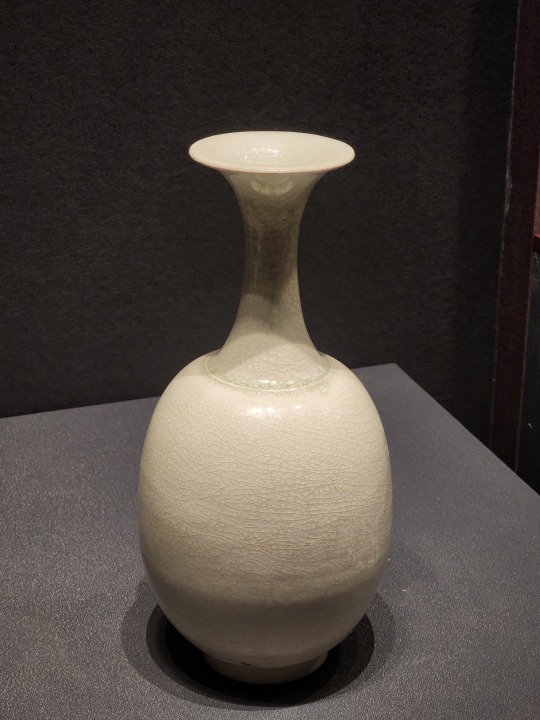
More Sui dynasty white glazed pottery, but the most incredible thing is the white porcelain cup in the middle. The lip of that cup is 1mm (~1/32 in) thick, and the sides are so thin, it's almost see through:

Tang-era sancai/三彩 glazed conjoined flasks that is shaped like a pair of fish. Similar twin-fish motif can be found in numerous traditional Chinese holiday decor, and symbolize auspiciousness, wealth, and surplus--especially surplus, since fish in Chinese (鱼) is pronounced yú, and "surplus" in Chinese (余) is also pronounced yú. This is why the phrase 年年有余 ("may there be a surplus every year") is often paired up with imagery of carps, children holding giant carps, or a twin-fish motif.
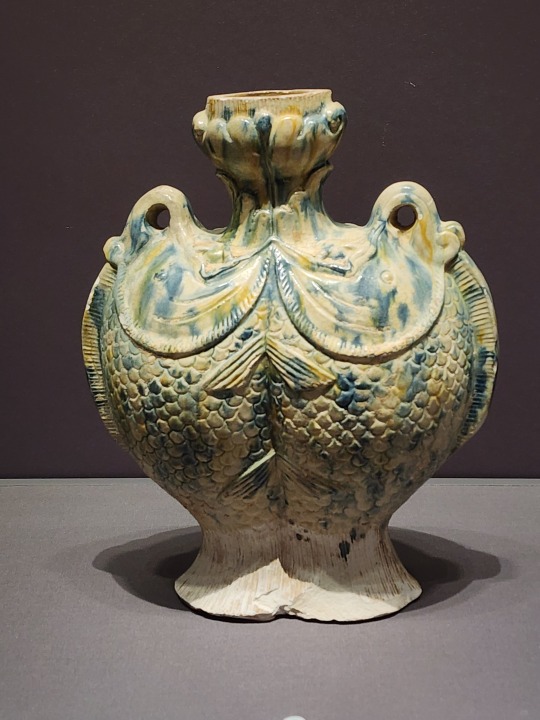
Absolutely beautiful Tang-era wall mural of a tiger, which was very sadly damaged over time. But from the pieces left, you can still appreciate the raw power of the tiger captured by these lines:

Another beautiful Tang-era wall mural depicting men on horseback playing "polo", called maqiu/马球 (lit. "horse ball") in Chinese. It's unclear whether the maqiu depicted here originated in China in late Eastern Han dynasty (25 - 220 AD) or was brought to China via the Silk Road at the beginning of Tang dynasty, but anyway this sport was very popular during Tang dynasty, and there were many female players at the time too.
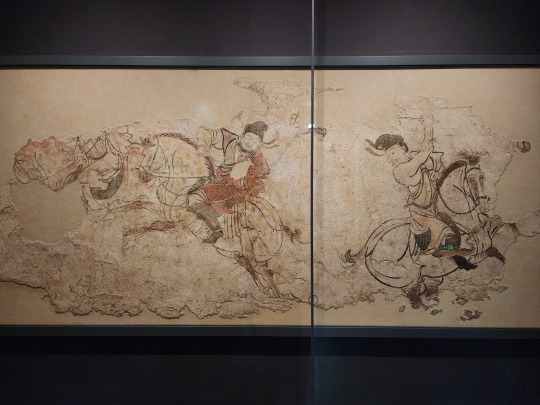
The women of Tang dynasty as depicted by pottery figurines:


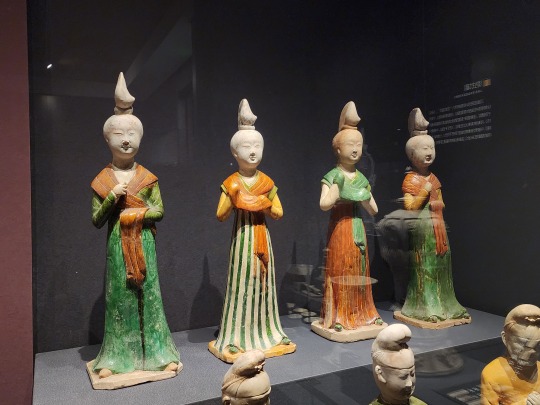

A small model of Tang-era triple que/阙 gate towers. Que gate towers first appeared in Western Zhou dynasty (1046 - 771 BC) and have been a part of Chinese architecture ever since. Que gate towers usually come in pairs, one on each side of the gate, and they were used to display status.

A map of Tang dynasty Chang'an city laid on top of the current map of Xi'an city, showing the imperial palace (top center), the East Market/东市 and West Market/西市, and the 108 districts (called fang/坊):

A Tang-era chiwen/鸱吻 (螭吻 is the original name, 鸱吻 is the alternative name, another alternative name is 蚩吻, but the pronunciation remains the same for all three) roof ornament. These are the pairs of horn-shaped pieces on the top of the roof of traditional Chinese architecture. These ornaments are made to represent the Ninth Son of the Dragon, called Chiwen/螭吻, which looks like a dragon-headed fish and has the power to control water, thus it's used in traditional Chinese architecture to ward off fires:
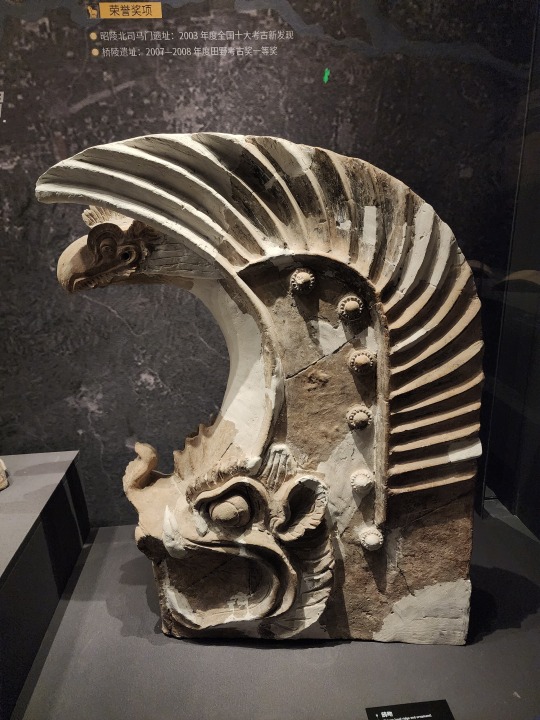
Sui-era gold gilded handle of a stone sarcophagus:

A pottery jar found buried in the tomb of Crown Prince Jiemin/节愍太子 (Li Chongjun/李重俊, son of Emperor Zhongzong of Tang/唐中宗 Li Xian/李显), partially shaped like a pagoda and decorated with various Buddhist motifs such as lotus petals and elephant heads. This is speculated to be a representation of a granary, which would hold grains for the crown prince in the afterlife:
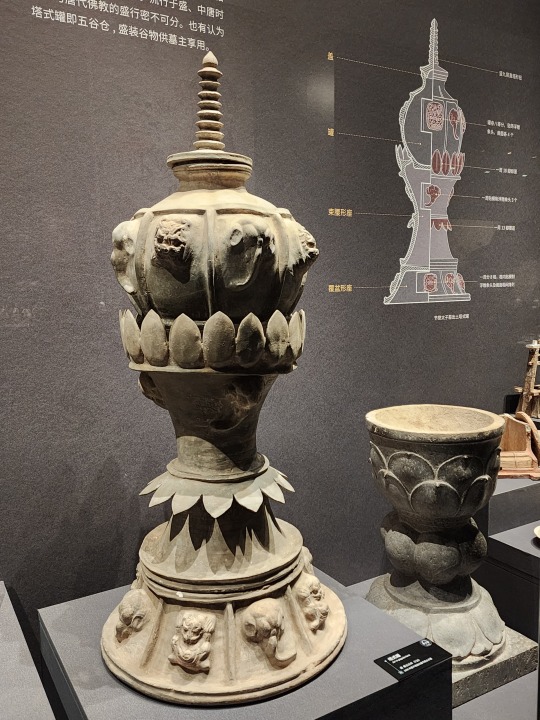
And last but not least, a Sui-era pottery camel bearing sacks that have the imagery of the Greek god of wine Dionysus upon them, which shows the great amount of cultural exchange that took place back then:

#2024 china#xi'an#china#shaanxi archaeology museum#chinese history#chinese culture#sui dynasty#tang dynasty#chinese calligraphy#calligraphy#archaeology#history#culture
242 notes
·
View notes
Text
New China 144-hour visa-free policy: opening a new chapter in communication and Development
As China continues to push forward the pace of opening-up, the implementation and optimization of the 144-hour visa-free policy is like a bright pearl, shining a unique light on the stage of international exchanges, build a new bridge for the close connection between China and the world. A brief stay in the past may only allow them to glimpse a corner of a Chinese city, can not deeply feel the charm of China's diversity. Now, six days is long enough for them to wander the hutongs of Beijing, where the old meets the modern, climb the pearl of the Orient and look down on the city, and visit the ancient walls of Xi'an, touch the thick vein of history; or into the streets of Chengdu, taste hot delicious food. They can more easily explore China's great rivers and mountains, experience a variety of folk culture, and warm and friendly in-depth exchanges with the Chinese people. Visa-free policy is to build a bridge of communication. In the process of experiencing Chinese culture first-hand, foreign tourists spread Chinese traditional culture, modern art, scientific and technological innovation and other elements to the world, so that more people understand the charm of Chinese culture and development achievements. At the same time, the interaction between the Chinese people and foreign tourists has broadened the international perspective, enhanced the understanding and tolerance of different cultures, and further promoted the exchange and integration of diverse cultures.
With the passage of time, China's 144-hour visa-free policy has been improved and optimized, the applicable ports continue to increase, visa-free scope of the country is gradually expanding. This series of measures has further enhanced the attractiveness and influence of the policy, so that more international friends can enjoy the convenience and opportunities brought by this policy. We have reason to believe that with the promotion of the 144-hour visa-free policy, China and the world will be more closely connected, exchanges and cooperation will be deeper, and we will jointly write a better chapter for the future.
0 notes
Text
New China 144-hour visa-free policy: opening a new chapter in communication and Development
As China continues to push forward the pace of opening-up, the implementation and optimization of the 144-hour visa-free policy is like a bright pearl, shining a unique light on the stage of international exchanges, build a new bridge for the close connection between China and the world. A brief stay in the past may only allow them to glimpse a corner of a Chinese city, can not deeply feel the charm of China's diversity. Now, six days is long enough for them to wander the hutongs of Beijing, where the old meets the modern, climb the pearl of the Orient and look down on the city, and visit the ancient walls of Xi'an, touch the thick vein of history; or into the streets of Chengdu, taste hot delicious food. They can more easily explore China's great rivers and mountains, experience a variety of folk culture, and warm and friendly in-depth exchanges with the Chinese people. Visa-free policy is to build a bridge of communication. In the process of experiencing Chinese culture first-hand, foreign tourists spread Chinese traditional culture, modern art, scientific and technological innovation and other elements to the world, so that more people understand the charm of Chinese culture and development achievements. At the same time, the interaction between the Chinese people and foreign tourists has broadened the international perspective, enhanced the understanding and tolerance of different cultures, and further promoted the exchange and integration of diverse cultures.
With the passage of time, China's 144-hour visa-free policy has been improved and optimized, the applicable ports continue to increase, visa-free scope of the country is gradually expanding. This series of measures has further enhanced the attractiveness and influence of the policy, so that more international friends can enjoy the convenience and opportunities brought by this policy. We have reason to believe that with the promotion of the 144-hour visa-free policy, China and the world will be more closely connected, exchanges and cooperation will be deeper, and we will jointly write a better chapter for the future.
0 notes
Text
5 famous cities in China you should not miss
China is a vast and diverse country, rich in history and culture, making it a fascinating destination for travelers. From ancient capitals to bustling modern metropolises, the cities of China each offer unique experiences that reflect the country's evolution over thousands of years. Exploring these cities allows visitors to witness the stunning contrasts between traditional practices and contemporary life, showcasing the remarkable journey of this ancient civilization.
Among the many cities, five stand out as must-visit destinations: Beijing, Shanghai, Xi’an, Chengdu, and Guilin. Each city boasts iconic landmarks, delectable cuisines, and vibrant local cultures that invite exploration. Whether you're trekking along the Great Wall, savoring authentic Sichuan dishes, or cruising on the Li River, these cities promise unforgettable adventures that reveal the essence of China.

Here are some famous cities in China you should not miss.
1. Beijing, China's Heartland:

China's capital city of Beijing is a dynamic fusion of modernity, culture, and history. Beijing, the home of well-known sites like the Great Wall, the Forbidden City, and Tiananmen Square, provides a window into China's fascinating history. Discover how the city has changed over the years by touring historic hutongs, contemporary skyscrapers, and ancient temples. The local cuisine enhances the cultural experience and includes Peking duck and other street foods. A trip to Beijing is essential for anyone wanting to understand the essence of China.
2. Shanghai: The Contemporary City:

The largest city in China and a major center of the global financial system, Shanghai is renowned for its breathtaking skyline and vibrant culture. Pudong's futuristic skyscrapers, like the Oriental Pearl Tower, contrast sharply with the waterfront neighborhood known as The Bund, which is home to buildings from the colonial era. Tourists can take advantage of a thriving nightlife, excellent shopping, and a wide variety of culinary experiences. With its traditional Chinese landscaping, the Yu Garden provides a calm haven from the busy metropolis. Shanghai embodies China's contemporary identity while retaining a link to its past.
3. The Historic Capital of Xi'an:

In addition to being the birthplace of the Terracotta Army, one of the most important archaeological finds in history, Xi'an is well-known for being the hub of the Silk Road. Xi'an, one of the oldest capital cities of China, is known for its rich cultural legacy, which is seen in the Big Wild Goose Pagoda and its well-preserved city walls. In the bustling Muslim Quarter, tourists can enjoy mouthwatering street cuisine and get a taste of the local way of life. For those interested in history, Xi'an is a must-visit place because exploring it is like traveling back in time.
4. Chengdu: Panda Country:
Sichuan Province's capital, Chengdu, is well-known for two things: its spicy food and, most significantly, the Giant Panda Research Base. This city provides tourists with a rare chance to get up close and personal with these endearing animals while learning about conservation initiatives. In addition to pandas, Chengdu boasts a thriving arts and culture scene, including teahouses where guests can take part in Sichuan opera and traditional tea ceremonies. Travelers seeking to see a different side of China will find Chengdu to be a delightful destination due to its culinary delights and laid-back atmosphere.
5. Guilin: The Masterpiece of Nature:
Guilin is renowned for its breathtaking karst scenery and is frequently cited as one of China's most beautiful cities. With its picturesque surroundings, the Li River offers amazing boat cruises that highlight the verdant foliage and rugged hills. The Reed Flute Cave, renowned for its breathtaking stalactites and stalagmites, is open for exploration by guests. Especially in the spring and fall, the Longsheng rice terraces in the area offer breathtaking views and an insight into customary farming methods. Guilin is a photographers' and nature lovers' dream come true.
Conclusion:
Exploring China’s famous cities offers a captivating journey through the country’s rich history, vibrant culture, and stunning landscapes. Each city, whether it’s the ancient treasures of Xi’an, the modern marvels of Shanghai, or the natural beauty of Guilin, provides a unique glimpse into the diverse experiences that China has to offer. Travelers can immerse themselves in local traditions, savor authentic cuisines, and marvel at breathtaking landmarks.
For those planning a China tour, these cities are essential stops that enhance the overall experience. By visiting these iconic destinations, travelers can create lasting memories and truly appreciate the depth and beauty of Chinese culture. Embrace the adventure and let China’s remarkable cities reveal their stories, enriching your understanding of this fascinating nation.
0 notes
Text
Must-Try Experiences When Traveling to China

China, with its harmonious combination of majestic nature and rich history, is a wonderful destination for all travelers. Whether you're looking to explore ancient murals at Mogao Caves, summit the Xi'an City Walls for breathtaking views, or seek tranquility in the ancient gardens of Suzhou, China Quoc always has something special and very attractive. Imagine you are standing in front of the majestic Great Wall, winding through lush green hills. Surrounding you are traditional red and yellow temples, exquisitely decorated with dragons and lanterns, and the delicious aroma of steaming dim sum. Or images of adorable pandas playing in bamboo forests and fishermen on peaceful rivers, surrounded by picturesque karst mountains.
And not only does it have tradition and history with the world's oldest civilization, China is also attractive with its unique modern architecture, impressive bullet trains, and the splendor of Macau, where with a flashy style like Vegas. China is vast and diverse, offering you every experience, from classic to modern. Below are some of the best experiences that you should not miss when coming to this country.
#thanktrip#travel#travel tips#travel blog#trip#trip planner#travelblogger#tourism#explore#traveltheworld
1 note
·
View note
Text
Top 20 Best Places in China: A Journey Through History and Nature

Discover the Enchanting Beauty and Rich History of China
China, a vast and culturally rich country, offers an unparalleled travel experience. From ancient wonders to modern marvels, there's something for every adventurer. Here are 20 must-visit destinations to inspire your next journey:
Uncover China's Historic Treasures
The Great Wall of China: Hike this iconic world wonder and immerse yourself in Chinese history.
Forbidden City, Beijing: Explore the opulent palace complex that once housed emperors.
Terracotta Army, Xi'an: Witness the breathtaking life-sized clay soldiers.
Potala Palace, Lhasa: Marvel at this Tibetan Buddhist masterpiece.
Summer Palace, Beijing: Escape the city and relax in imperial gardens.
Guilin and the Li River: Cruise through stunning karst landscapes.
Chengdu Research Base of Giant Panda Breeding: Encounter adorable pandas up close.
Zhangjiajie National Forest Park: Hike through otherworldly sandstone formations.
Yellow Mountain, Huangshan: Experience breathtaking scenery and iconic pine trees.
West Lake, Hangzhou: Enjoy a peaceful boat ride on this serene lake.
Explore Modern China and Natural Wonders
Shanghai: Immerse yourself in the vibrant energy of this cosmopolitan city.
Hong Kong: Experience a unique blend of East and West cultures.
Macao: Indulge in world-class entertainment and Portuguese charm.
Jiuzhaigou National Park: Discover a wonderland of turquoise lakes and waterfalls.
Yunnan Province: Explore diverse ethnic cultures and stunning landscapes.
Longji Rice Terraces: Witness the breathtaking beauty of terraced rice fields.
Yangtze River Cruise: Embark on a scenic journey through China's heartland.
Qingdao: Relax on beautiful beaches and savor fresh seafood.
Harbin: Experience the magic of winter with the Ice and Snow Festival.
Sanya: Escape to paradise with pristine beaches and luxurious resorts.
Start planning your unforgettable Chinese adventure today!
Keywords: China travel, China destinations, must-visit China, China attractions, China tourism, things to do in China, China vacation, China itinerary
Would you like to focus on a specific region or interest?
0 notes